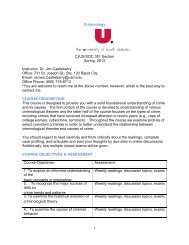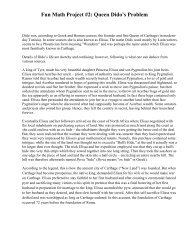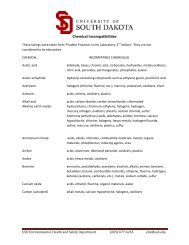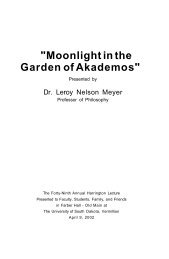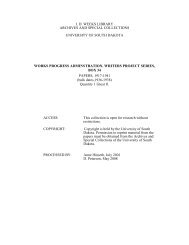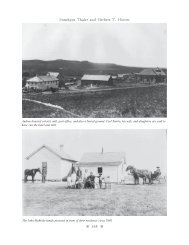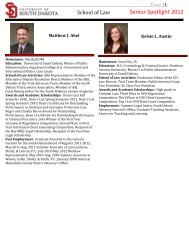Psychometric Properties of the Chinese Leadership Practices ...
Psychometric Properties of the Chinese Leadership Practices ...
Psychometric Properties of the Chinese Leadership Practices ...
Create successful ePaper yourself
Turn your PDF publications into a flip-book with our unique Google optimized e-Paper software.
International Journal <strong>of</strong> Nursing Education Scholarship, Vol. 4 [2007], Iss. 1, Art. 23<br />
For construct validity, three factors were extracted from <strong>the</strong> 28-item<br />
<strong>Chinese</strong> LPI-observer using PAF analysis with direct oblimin rotation, and<br />
accounted for 57.3% <strong>of</strong> <strong>the</strong> total variance. The item 7 shares future dream, item<br />
16 looks for ways to improve, item 19 talks about guiding beliefs, and item 22<br />
forecasts <strong>the</strong> expected future did not meet <strong>the</strong> criterion <strong>of</strong> factor loading greater<br />
than .40 and were eliminated. The possible reason for dropping <strong>the</strong>se four items is<br />
that Taiwan’s nursing faculty perceived little about nursing leaders’ vision and<br />
belief related to specific leadership behavior. Taiwan’s nursing deans or directors<br />
may face restrictions in <strong>the</strong>ir decisions from <strong>the</strong>ir presidents and deans <strong>of</strong><br />
academic affairs; in turn, nursing deans or directors may not fully display<br />
conviction in <strong>the</strong>ir commitments, owing to limited authority (Chen, Beck, &<br />
Amos, 2005). Three factors <strong>of</strong> <strong>the</strong> <strong>Chinese</strong> LPI are consistent with Tourangeau<br />
and McGilton’s (2004) study in which <strong>the</strong> third edition <strong>of</strong> <strong>the</strong> LPI was used and in<br />
which three new factors named cognitive, behavioral, and supportive practices<br />
were proposed. As a result <strong>of</strong> deleting four items through factor analyses,<br />
psychometric properties were reexamined to demonstrate <strong>the</strong> improvement <strong>of</strong> <strong>the</strong><br />
24-item <strong>Chinese</strong> LPI-observer.<br />
<strong>Psychometric</strong> <strong>Properties</strong> after Deleting Six Items<br />
The Cronbach’s alpha coefficient for <strong>the</strong> 24-item <strong>Chinese</strong> LPI-observer<br />
total scale was .96, which was <strong>the</strong> same as <strong>the</strong> original 30-item <strong>Chinese</strong> LPI and<br />
consistently demonstrated acceptable reliability. For item analysis, all <strong>of</strong> <strong>the</strong><br />
interitem and corrected item-total correlation coefficients showed acceptable<br />
homogeneity within <strong>the</strong>se 24 items. In factor analysis, <strong>the</strong> three same factors were<br />
extracted that explained 59.5% <strong>of</strong> <strong>the</strong> total variance, which was close to <strong>the</strong><br />
results <strong>of</strong> Posner and Kouzes’ (1988, 1993) studies. The results <strong>of</strong> concurrent<br />
validity show that <strong>the</strong> <strong>Chinese</strong> LPI-observer total and subscales are highly and<br />
positively correlated with <strong>the</strong> transformational leadership subscale <strong>of</strong> <strong>the</strong> <strong>Chinese</strong><br />
MLQ-5X, which means that both scales represent <strong>the</strong> similar concepts <strong>of</strong><br />
leadership behavior. Concurrent validity is also supported by <strong>the</strong> significantly<br />
negative relationships among <strong>the</strong> <strong>Chinese</strong> LPI-observer total and subscales and<br />
<strong>the</strong> laissez-faire subscale <strong>of</strong> <strong>the</strong> <strong>Chinese</strong> MLQ-5X. The laissez-faire style is a<br />
nonleadership factor-nontransformational and nontransactional.<br />
Interpretation <strong>of</strong> Three New Factors<br />
Factors were named according to items with higher loadings and item<br />
meaning. Factor one, enabling o<strong>the</strong>rs to act, contains eight items (items 3, 8, 9, 13,<br />
18, 21, 23, and 28) from most <strong>of</strong> Posner and Kouzes’ (1988) original leadership<br />
practices <strong>of</strong> enabling o<strong>the</strong>rs to act (see Table 2). This factor is similar to <strong>the</strong><br />
http://www.bepress.com/ijnes/vol4/iss1/art23<br />
10



